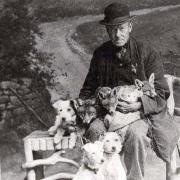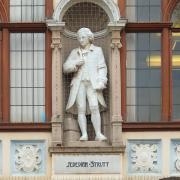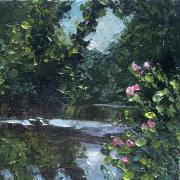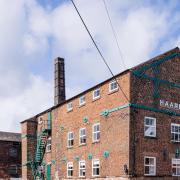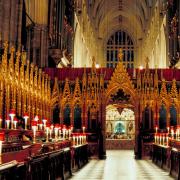Derbyshire Life follow the trail of the ‘Queen of Crime’

Ninety years ago, on 3rd December 1926, a distraught 36-year-old woman mysteriously vanished without trace from her home in Berkshire. She was the crime writer Agatha Christie.
A massive search and huge media interest ensued. First suicide and then murder were suspected. So no wonder eyebrows were raised when the ‘Queen of Crime’ was dramatically discovered 11 days later enjoying an incognito break at a Harrogate spa establishment. At a stroke Christie became the centre of her very own mystery – one never fully solved.
Relentlessly pursued by the press after her startling reappearance, Christie needed sanctuary at what was evidently a crisis point in her life – it was discreetly provided by her brother-in-law James Watts (1878-1957) at his family seat Abney Hall in Cheshire close to the Derbyshire border. There begins the Derbyshire twist – for Watts was also one of the foremost landowners in the High Peak.
Along with property in the Derbyshire village of Hayfield, he held vast tracts of moorland around Kinder Scout. This he managed for the coveted shooting rights enjoyed by the ‘hunting, shooting and fishing’ set who made Kinder their exclusive playground in that very different era before the days of ‘access for all’.

In such troubled circumstances Christie’s curiously providential family connection with Derbyshire first came to public notice – and she retained a close affinity with the county which ran as an influential thread through the rich fabric of her life. Indeed her Derbyshire links through James Watts had a subtle bearing on her success as the world’s best-known female mystery writer.
Agatha Mary Clarissa Miller was born in 1890 into comfortable surroundings in Torquay, South Devon, acquiring her writing name through marriage to Archibald Christie on Christmas Eve 1914. Although most closely associated with the south, a northern link existed via her mother Clara, who for much of her childhood lived near Manchester, and the Derbyshire connection was first forged when Clara’s best friend married a wealthy Manchester merchant. He was James Watts senior, whose family lived in the huge Victorian mansion Abney Hall in Cheadle, Cheshire, but spent significant leisure time on their Kinder estate.
Agatha began visiting the Watts family with her mother and sisters whilst still a schoolgirl – and the family’s eldest son James Watts junior became her brother-in-law in September 1902 when he married Agatha’s elder sister Madge. They made their home at Cheadle Hall.
Throughout her teens and married life Agatha became a regular house-guest of her sister and brother-in-law, especially at Christmas, when she variously stayed at Cheadle Hall, Abney Hall, and the Hayfield properties, first Farlands House just outside the village, and later Upper House Farm on the slopes above Kinder Reservoir. It remains an impressive property still with its own hunting lodge – now a splendid function venue proud of its history and curious Christie links.

Agatha both liked and trusted James Watts, and her close connection with him was to play a fortuitous part in her writing success.
Her first book – The Mysterious Affair at Styles – published when she was 30 in 1921, introduced her readers to the master Belgian detective Hercule Poirot. But Christie might well have remained merely an amateur writer had she not raised Poirot’s status to that of detecting genius within just a few short years.
This she admirably achieved through the 1924 collection of short stories Poirot Investigates, in one of which he solves a grisly Derbyshire murder from his London bed – where he is confined with influenza – entirely by deduction from remote feedback via his trusty sidekick Captain Hastings. This ingenious tale The Mystery of Hunter’s Lodge was adapted for television in 1991. Set at a grouse shoot on the Derbyshire moors near Elmer’s Dale – a thinly-veiled Edale – its plot was directly inspired by Christie’s visits to the area.
Fittingly the Peak District was used ‘on location’ – Casterne Hall near Ilam doubling as Hunter’s Lodge. In this version Poirot actually attends the ill-fated grouse shoot and falls ill – indeed David Suchet playing Poirot really did catch ‘a terrible cold’ during filming – an authentic touch!

Christie even draws on the county for names in the narrative – Poirot’s friendly rival, the hapless Inspector Japp, stays during the case at the Matlock Hotel while the shadowy character around whom the plot revolves is Mrs Middleton.
Agatha surely borrowed the name from the village by Wirksworth – for it is by no means the only Peakland label used in her works. Lady Frances Derwent, the Cavendish family, Jack Hartington and Evelyn Hope all pop up – as do Mary Dove and, naturally enough, Sylvia Dale.
There are many more besides, including adventurous husband and wife detective team Tommy and Tuppence Beresford who neatly continue the dale theme. And is it pure coincidence that St Edmund’s church in Fenny Bentley contains the mysterious shrouded effigy of Thomas Beresford, Derbyshire’s 15th century namesake, and his wife? The plot thickens!
Lest there be any doubt that Christie did draw on place names away from the more obvious south, consider that just a few miles west of Hayfield adjacent to the county border is the town of Marple, surname of the sleuthing spinster who made her debut in Murder at the Vicarage in 1930. Christie confirmed that Miss Jane Marple was indeed named after the town.

The Poirot short stories were a great success but Agatha herself said she was ‘never a writer by profession’ until the 1926 publication of her full-length blockbuster The Murder of Roger Ackroyd. Yet again this classic with arguably the most famous ending in crime fiction is shot through with Derbyshire spirit, for the fiendishly cunning plot (some say downright unfair!) was suggested by James Watts himself after he told Agatha that her early works were becoming ‘too predictable’.
The book proved a sensation and rocketed its rather shy author to celebrity status. The pressure of this, coupled with her mother’s death and the shock discovery of her husband’s infidelity, combined to bring about her 1926 ‘breakdown’ and disappearance.
Perhaps James Watts felt partly responsible for thrusting his rather private sister-in-law into the literary stratosphere. At any rate, once Mrs Christie had been unmasked in Harrogate, Watts took the lead in arranging her recuperation at Abney Hall. Christie remained eternally grateful to him for this. And in turn Watts remained forever loyal. More than anyone else he knew the full story of her disappearance but when he died in 1957 the secret went with him. The entire strange episode was dramatised in the controversial 1979 feature film Agatha in which the part of her unfaithful husband was played by Belper-born actor Timothy Dalton.
Given time to lie low at Abney Hall, Christie emerged stronger and wiser to pursue her now legendary career, remarrying in 1930 to the archaeologist Max Mallowan, and continuing her Hayfield visits for many years. These were often in the company of her daughter Rosalind who later recalled in correspondence ‘those happy days at our Upper House Farm retreat’.
Agatha undoubtedly used James Watts’s homes in Cheshire and Derbyshire as something of a ‘bolt-hole’ away from the spotlight – they also formed the templates for most of the country-house settings in her works. She always felt James to be a kindred spirit, so much so that in 1938 she wrote a novel especially for him after this time he told her she had become ‘too civilised’.
‘I want a good violent murder, with lots of blood’, he said. Christie duly obliged with the festive offering Hercule Poirot’s Christmas. The book carries a dedication to Watts as ‘one of the most faithful and kindly of my readers’ and finishes ‘so this is your special story, written for you… your affectionate sister-in-law… Agatha’. This was a lasting acknowledgment that the ‘Derbyshire landowner’ had played such a personal part in Christie’s route to success.
Agatha Christie’s mystery books have been outsold in the Western world only by Shakespeare and the Bible. She also wrote poetry and romance under the pseudonym Mary Westmacott. She died on 12th January 1976 aged 86, but her spirit lives on in nearly 70 novels and over a hundred short stories.
Her popularity has not only endured but seems to be widening – and Christie fans are in for more treats, as new TV adaptations, a literary pastiche, and major films are on the horizon.
Today the Kinder Scout moorlands are a magnet for walkers from far and wide. Yet how many realise that in another age the peace and majesty of the High Peak inspired the ‘Duchess of Death’ – as Christie preferred to be known – to create deeds most foul?
Let us close with a seasonal message from the hand of the always macabre Mrs Christie. In The Adventure of the Christmas Pudding (1960) – which after James Watts’s death she dedicates to ‘all the happy Christmases I spent with the Watts’s in the North’ – she inflicts Christmas Day malaise on an already restless Hercule Poirot via an anonymous note sent to his room. Fittingly it employs the Derbyshire vernacular: ‘DON’T EAT NONE OF THE PLUM PUDDING. ONE WHO WISHES YOU WELL.’










